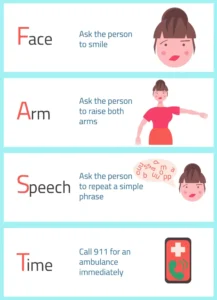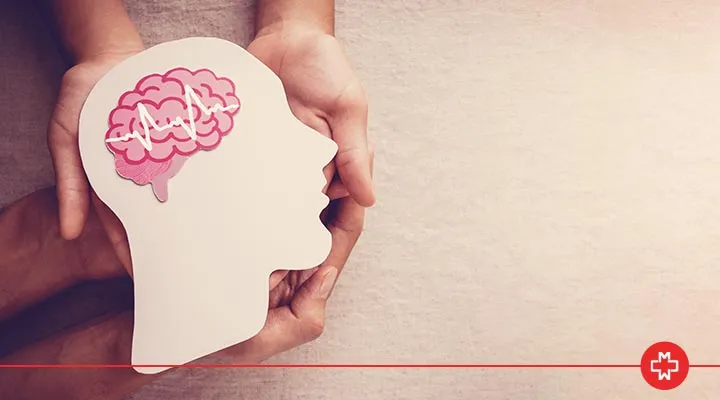A stroke also known as a brain attack or a cerebrovascular accident (CVA) is caused by a blockage in the blood supply at a specific area of the brain. It can also occur when a certain vessel in the brain ruptures which causes a bleed. A stroke can affect the entire body or a specific part of it.
In the United States alone every 40 seconds someone has a stroke and every 4 minutes someone dies because of it. It is one of the leading causes of death in America.
A stroke is a medical emergency and according to the CDC, it should be treated immediately to avoid disability or even death. The early signs of stroke are at times overlooked by people. In this article, we’ll talk about the early signs and symptoms of stroke so you don’t miss them and seek immediate medical attention if you experience any of them.
The 5 Warning Signs of a Stroke
The following are the primary warning signs of stroke:
- A sudden numbness or frailty in the face, arm, and leg. More specifically on one side of the body.
- Confusion and difficulty speaking
- Vision issues in both or one eye
- Severe stroke headaches
- Balance issue or difficulty walking
Act F.A.S.T
It is recommended by many physicians and health institutes to act FAST if they are experiencing any stroke-related symptoms. The treatments that are available for stroke are more effective if the stroke is diagnosed within the first three hours of exhibiting symptoms. The acronym of F.A.S.T (Facial drooping, Arm weakness, Speech difficulties, and Time to call 911) was coined by a group of physicians in the United Kingdom in 1998 to negate the urgency of stroke in the eyes of emergency responders. The acronym is used to define the initial warning signs of stroke and how a person should respond if they experience such signs.

Types of Stroke
There are three common types of stroke that are quite prevalent in the United States
1. Ischemic Stroke:
Ischemic stroke or brain ischemia is the most common type of stroke. It accounts for about 87% of all strokes. It happens when an artery or vessel providing blood to the brain is blocked due to plaque (atherosclerosis). The blockage stops the flow of oxygen and blood to the brain. If the flow is restored quickly, it can cause permanent damage and can also lead to death.
2. Hemorrhagic Stroke
Hemorrhagic stroke is a relatively less common type of stroke. It accounts for up to 13% of all strokes. It is caused when the vessels or arteries that carry blood to the brain are weakened which leads to them rupturing and causing brain bleeds. The blood accumulates in the brain and compresses the surrounding brain tissues. There are two main causes of hemorrhagic stroke: aneurysms and arteriovenous malformations (AVMs).
3. Transient Ischemic Attack (TIA)
A Transient Ischemic Attack is often referred to as a ministroke. This is caused due to temporary blockage or a decrease in blood flow to the brain. The symptoms subside eventually with it. TIA doesn’t usually cause permanent damage but they are signs of a full-blown stroke ahead.
Signs and Symptoms of stroke in women
According to the CDC, 1 in 5 women in the United States have a stroke at least once in their life and nearly 60% of them will die because of it. It is the third leading cause of death amongst American women. According to many types of research, women are more likely to have a stroke mostly because of high blood pressure. It can also be caused by pregnancy or consuming birth control. The symptoms and signs of stroke in women are slightly different than in men. These symptoms include:
- Seizures
- Nausea and vomiting
- Hiccups
- Difficulty breathing
- General weakness
- Fainting
- Hallucinations
- Sudden behavioral changes
- Disorientation
- Agitation
Because these symptoms are different from usual stroke, it is often difficult to connect them with stroke. This can sometimes delay treatment and cause other complications.
Preventing a Stroke
Strokes are relatively hard to predict but if you have some ongoing health problems like high blood pressure, extreme weight gain, or diabetes, the chances of you having a stroke are higher. High blood pressure is the most common cause of hemorrhagic stroke. If you have any of these problems try managing them to avoid having a stroke. Here are some key pointers and tips on what you can do to prevent stroke:
- Keep your blood pressure in check:
Make sure your blood pressure is not getting too high. Try to maintain it around 120/80. If you are above 40 it might be hard to keep it within those ranges so take some medication for it.
- Quit Smoking
Smoking accelerates clot formation which leads to stroke. It thickens the blood in your body. This is a significant lifestyle change that you can make to prevent stroke
- Healthy Lifestyle
This includes eating healthy, drinking lots of water (very important), and exercising regularly. Exercise can help in losing weight and can also help in lowering blood pressure. Overall a healthy lifestyle will ensure a healthy weight and a good body mass index (BMI) of 25 or less.
- Manage Diabetes
If you have a high blood sugar level it can weaken the blood vessels and arteries over time. Try to keep your blood sugar level under control. You can do so by practicing some diabetes management tips and tricks like monitoring your blood sugar level and avoiding high sugar food.
- Treat Atrial Fibrillation
Atrial Fibrillation is a cardiac disease that causes irregular heartbeats that can lead to clot formation that can travel to the brain. This condition carries a major risk of stroke. If you have this condition, consult your physician immediately and get yourself treated.
Bottom Line
The early signs of stroke are often very unnoticeable and some other conditions, like migraines and seizures, mimic the signs of stroke. So, as common as this condition may be it is often overlooked by many people. If you are exhibiting any of the early signs of stroke, rush to a neurology center near you and in case you have a family history of stroke consult our expert neurologist to make sure you can prevent it from happening.
– Disclaimer –
This blog is for informational & educational purposes only, and does not intend to substitute any professional medical advice or consultation. For any health related concerns, please consult with your physician, or call 911.
Last reviewed by Dr. Syra Hanif, M.D. on 06/14/2021
Learn more about our editorial process.
-
About The Author
Dr. Syra Hanif M.D.Board Certified Primary Care Physician
Dr. Syra Hanif is a board-certified Primary Care Physician (PCP) dedicated to providing compassionate, patient-centered healthcare.
Read More


